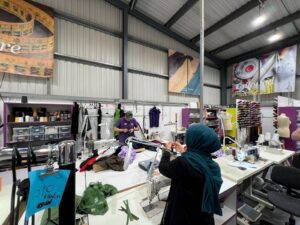Q&A with Sue Evans of the Central Scotland Green Network
 Sue Evans is head of development at the Central Scotland Green Network – and co-author of Growing Awareness.
Sue Evans is head of development at the Central Scotland Green Network – and co-author of Growing Awareness.
She explains how central Scotland is developing a ‘green’ consciousness for sustainable social and economic development
What is the Central Scotland Green Network (CSGN)?
The CSGN aims to restore and transform the landscape of central Scotland. Its vision is set out in the Scottish government’s national planning framework and its aim is that, by 2050, central Scotland has ‘been transformed into a place where the environment adds value to the economy and where people’s lives are enriched by its quality’. The initiative covers central Scotland, an area of 10,000km2, 19 local authorities and a population of 3.6m, almost two-thirds of Scotland’s population. The network stems from efforts by the previous governments as far back as 1970s land renewal and 1980s countryside around towns projects. Scotland is a typically post-industrial place, with a history of steelworks and shipping and extraction of iron ore and coal. What we want to do is to deal with the legacy of vacant and derelict land and the social issues resulting from these past uses through land regeneration of areas over time. The CGSN was set up to provide capacity to help greening initiatives go forward, but the drive will also come from local authorities and businesses as well as agencies like Forestry Commission Scotland.
You have recently published a book called Growing Awareness: how green consciousness can change perceptions and places. Where did the idea for the book come from?
Each year since 2011 we have held a one-day conference at which we’ve heard from fantastic speakers talking about their projects and the possibilities for ‘greening’ places. As we now have five years’ worth of material we thought it would be good to write a book to celebrate that learning and disseminate it to others. The book features the lessons from a range of ‘green’ regeneration projects, from the High Line in New York to the south Pennines Watershed Landscape project.
How far is green infrastructure becoming a fundamental part of planning and design?
As part of the national planning framework in Scotland it is now a requirement for local authorities to incorporate green infrastructure into their planning proposals. So now you see it raised in new local development plans and supplementary planning guidance . There has been a lot of work by the third sector organisations like Sustrans on active travel, we have a new national cycling and walking strategy in Scotland and other supportive policy and local authorities are seeking funding for green infrastructure projects. For example, Glasgow City Council has a major regeneration project at Sighthill – one of its Transformational Regeneration Areas in the north of the city – where it is working closely with partners like Scottish Canals. There’s also been a CSGN development fund since 2011 which is helping to kick-start projects and to pay for feasibility studies and other support. The fund is a catalyst to get things off the ground and now we are seeing the delivery of some of those projects.
 Is the fact that ‘green’ projects can boost local economies important?
Is the fact that ‘green’ projects can boost local economies important?
It strengthens the arguments. We can talk to colleagues across government about active travel plans and derelict land and engage with NHS Scotland on the benefits of greenspace for physical and mental wellbeing. We want to get to the position where green infrastructure is seen for what it can deliver: as much, if not better than, ‘grey’ infrastructure. As Professor Brian Evans, co-author of the book, said, green infrastructure needs to move beyond being a ‘bridesmaid activity’ to being absolutely mainstream.
What are the social impacts of green planning?
The article in the book by Sir Harry Burns is important. He was the chief medical officer for Scotland. He flags the link between poor environment and poor wellbeing. If you live in a place with a bad environment you don’t want to go outside. What’s important in deprived places is that the environment is safe and clean and well looked after. The health statistics for Scotland are bad but only started getting bad in the 70s. If we deal with some fundamental issues about people not being in control of their lives and help them to become more self-determining, growing their own food etc, we should see those statistics change for the better. Forestry Commission Scotland has got some good projects involving people in local decisions around urban woodlands. Not only is the environment improved but local people are also engaged. GPs are now prescribing fresh air and that recognition that the outdoors and a good quality environment is important to physical and mental wellbeing is great to see being mainstreamed.
What are the key lessons coming through in the book?
Clarity of vision is important; you don’t necessarily need a masterplan but you do need a strong vision. The most successful projects are those that are rooted in place and appropriate to that place. The most successful projects have good governance, dedicated people and a long corporate memory which help to ensure that early investments are built upon and allow ordinary people to see that change is possible and can be sustained. It’s about how organisations work and how they forge partnerships. One of the projects narrated in the book is the Emscher Landscape Park in the Ruhr region of Germany. It’s a great example of over 50 small cities working together in partnership and cooperating to make their vision a reality.
- Growing Awareness: how green consciousness can change perceptions and places is available here















